Should You Marinate Meat Before Stir Frying? The Ultimate Guide to Marinating Meat for Stir Fry
Stir-frying is a popular cooking technique that involves quickly cooking ingredients in a hot wok or skillet. Marinating meat before stir-frying is a crucial step that can significantly enhance the flavor and texture of the dish. This guide will delve into the benefits of marinating meat for stir-fry, explore various marinating techniques, and provide tips for creating the perfect marinade.
Benefits of Marinating Meat for Stir-Fry
Marinating meat before stir-frying offers several advantages:
- Tenderizes the meat: Marinades contain enzymes that break down the proteins in meat, making it more tender and juicy. This is especially beneficial for tougher cuts of meat.
- Enhances flavor: Marinades infuse the meat with flavor, allowing it to absorb the aromatic compounds and spices. This results in a more flavorful and complex dish.
- Retains moisture: Marinating helps retain moisture in the meat, preventing it from drying out during the high-heat cooking process of stir-frying.
- Promotes even cooking: A marinade helps the meat cook more evenly, ensuring that it is cooked through without overcooking the exterior.
Types of Marinades
There are various types of marinades that can be used for stir-frying, each with its unique flavor profile:
- Acidic marinades: These marinades use acidic ingredients such as vinegar, lemon juice, or yogurt to tenderize the meat. Examples include teriyaki marinade, soy-ginger marinade, and citrus-herb marinade.
- Oil-based marinades: These marinades use oil as the base, along with herbs, spices, and other flavorings. They help seal in moisture and add richness to the meat. Examples include olive oil marinade, sesame oil marinade, and garlic-herb marinade.
- Yogurt-based marinades: These marinades use yogurt as the base, which tenderizes the meat and adds a tangy flavor. Examples include yogurt-tandoori marinade, yogurt-mint marinade, and yogurt-curry marinade.
How to Create the Perfect Marinade
The key to creating the perfect marinade lies in balancing the following elements:
- Acid: Acidic ingredients tenderize the meat and enhance its flavor. Use citrus juices, vinegar, or yogurt as the acidic base.
- Oil: Oil helps seal in moisture and adds richness. Choose a neutral oil such as canola oil, vegetable oil, or grapeseed oil.
- Herbs and spices: Herbs and spices provide flavor and aroma. Experiment with different combinations to create a unique marinade.
- Salt and sugar: Salt enhances the flavor of the meat, while sugar helps caramelize it during stir-frying.
Marinating Techniques
Once you have created your marinade, it is time to marinate the meat:
- Submersion: Place the meat in a container and completely submerge it in the marinade. Cover and refrigerate for at least 30 minutes, or up to overnight.
- Injection: Use a marinade injector to inject the marinade directly into the meat. This method ensures even distribution of the marinade and reduces marinating time.
- Brining: Brining involves soaking the meat in a salt solution before marinating. This helps draw out moisture and allows the marinade to penetrate more deeply.
Tips for Marinating Meat for Stir-Fry
- Use fresh, high-quality meat: The quality of the meat will directly impact the flavor of the dish.
- Slice the meat thinly: Thinly sliced meat will marinate more quickly and evenly.
- Marinate for the right amount of time: Marinating for too long can make the meat mushy. For stir-frying, 30 minutes to overnight is usually sufficient.
- Refrigerate the marinade: Always refrigerate the marinade to prevent bacterial growth.
- Discard the marinade after use: Do not reuse the marinade after it has been in contact with raw meat.
Conclusion
Marinating meat before stir-frying is an essential step that can elevate the flavor and texture of your dish. By understanding the benefits of marinating, experimenting with different types of marinades, and following the proper techniques, you can create mouthwatering stir-fries that will impress your family and friends.
How to Cut Beef for Lo Mein & Other Noodle Dishes
It takes an additional step to slice the beef into thin strips (julienne) if it is to be used in noodle dishes or dishes like Beef and Pepper Stir Fry.

When preparing Chinese stir-fries, it’s important to cut ingredients uniformly. When stir-frying beef with vegetables, such as beef and broccoli or beef and tofu, rectangular slices of beef are used. To make long noodles like those in Beef Lo Mein, the beef must be sliced into long, thin strips.
For the small grains of rice in beef fried rice, there must be small chunks of meat. Make sense?.

Cutting Boneless Beef Chuck for Stir-fry
It’s crucial to cut meat against the grain if you want your stir-fry dishes to have nice, tender pieces.
Once more, the term “grain” describes the lengthy, parallel-running muscle fibers that run through the beef. Cutting across the strands of muscle to create small, tender pieces can be accomplished by cutting against the grain.
Finding the grain pattern in a beef chuck is far more difficult than finding it in a flank steak. The pattern of meat and fat where the grain runs vertically is visible in this picture.
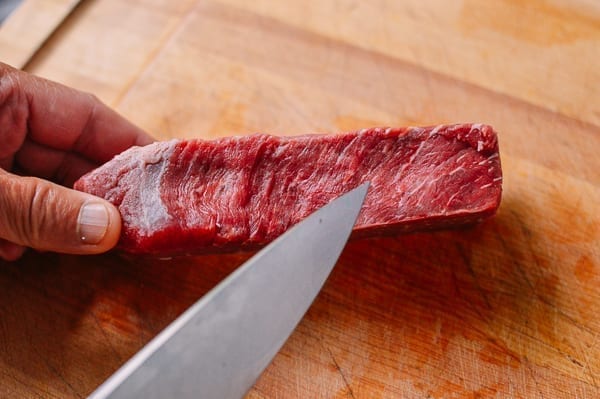
This piece requires us to cut crosswise to the grain, so we must first cut the long strip into chunks that are two inches wide.
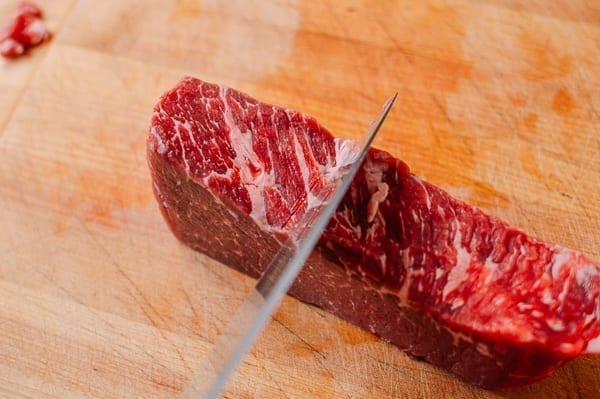
Next, arrange each component so that the long fibers are sliced short.
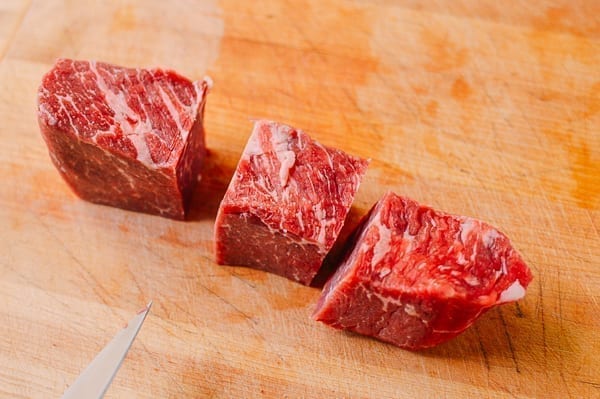
Can you see how the knife is angled to cut the beef against its grain?
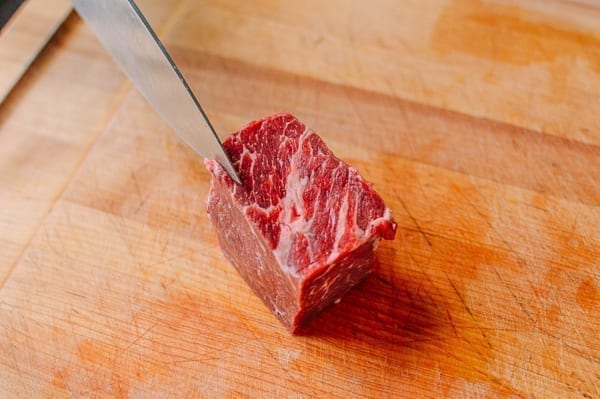
Now, cut your beef into 1/4″ thick slices…
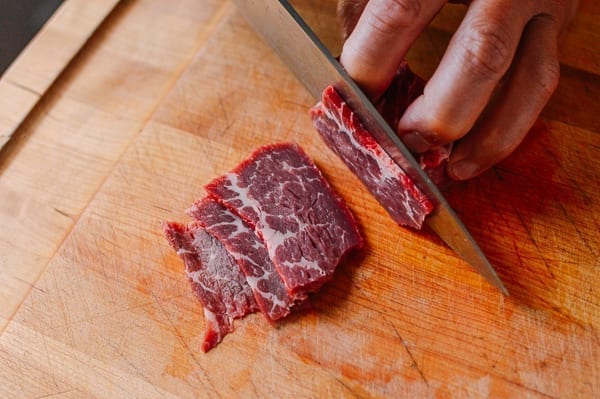
Although the grain and slice are a little more visible in this picture, you can still imagine how challenging it can be to handle and slice soft beef.
The key to a chef’s speedy beef slicing is to partially freeze the meat for 30 to 60 minutes, or until firm.
Because the firm beef won’t slide under your knife and around the cutting board, slicing will be much simpler and quicker. Meat that has partially frozen also enables you to cut it more precisely to the appropriate thickness.
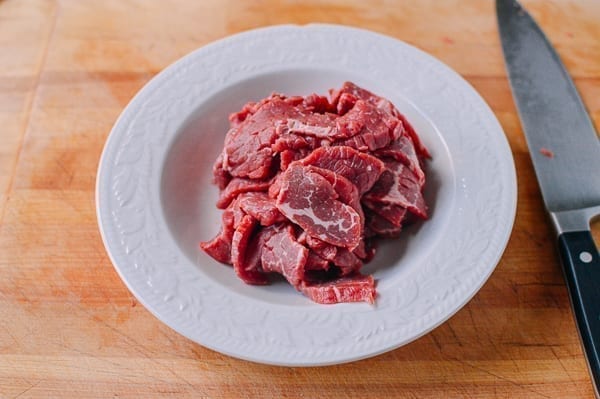
Why I Wash my Meat Before Stir-Frying | Kenji’s Cooking Show
FAQ
How do Chinese make their meat so tender?
What do the Chinese use to marinate meat?
Do you cook meat before stir-fry?
Do you marinate beef in a stir fry?
Most beef marinades for stir-fries are simple and easy anyway, so you definitely don’t want to skip the marinating step. Whenever I make any type of beef stir fry recipes like my Beef Chow Fun, Cantonese Beef Chow Mein, Stir Fried Bitter Melon, or Beef Noodle Stir Fry, I always marinate the beef.
What can be used as a substitute for hoisin sauce in beef stir fry?
You can use it as a substitute for hoisin sauce in beef stir fry: soy sauce, barbecue, tamari, hot sauce, teriyaki sauce, and sweet and sour sauce.
Should you marinate meat before cooking?
Meat should be sliced, vegetables chopped, sauces mixed, and aromatics minced, all before you turn up that heat. But there’s another secret that will improve both the flavor and the texture of your proteins: proper marinating. When done right, a marinade is more than just a flavoring agent.
How long does beef stir fry marinade take?
Beef stir fry marinade is an Asian cooking staple. This quick marinade takes only 15 minutes and requires no chopping or grating. Use this marinade to flavor and tenderize beef for a perfectly juicy stir fry—just like your favorite Chinese takeout!
